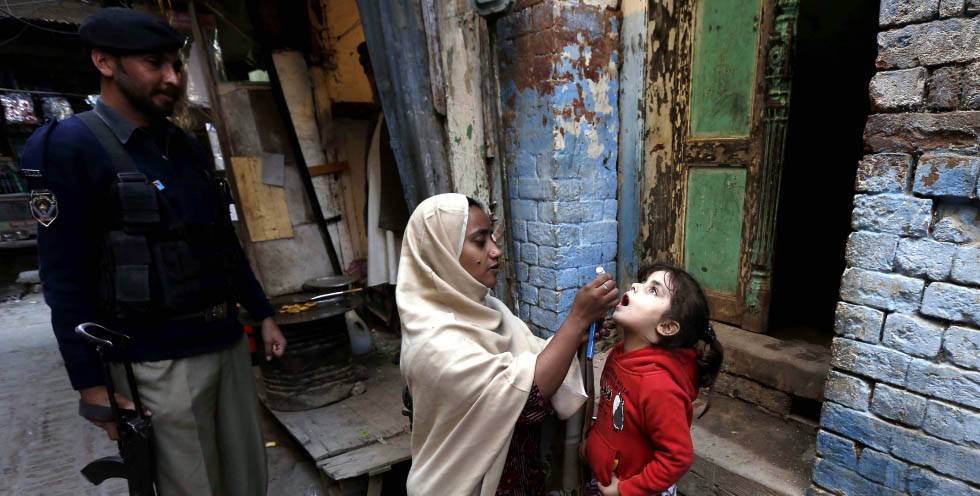
Low routine immunisation coverage in Pakistan is a basic reason of increase in polio cases and other diseases

With the rise in polio cases in 2014 despite several years of vaccination campaigns in Pakistan, dismal routine immunisation coverage is considered a major reason for failure in eradicating polio in parts of the country.
According to a survey of Pakistan Social and Living Standards Measurement (2010-2011), Pakistan’s routine immunisation coverage does not meet the optimal routine immunisation rate of more than 80 per cent.
The average coverage of routine immunisation in Pakistan is close to 65 per cent with only important cities of Punjab recording a better performance. There is a huge difference of routine immunisation coverage between provinces and districts, and cities are at the root of the current measles outbreak.
According to the World Health Organisation (WHO), at an average, one Extended Programme on Immunisation (EPI) vaccination centre in a union council caters for a population of 20,000 to 30,000, which is simply not enough to cater to the total population of any unit.
Dr Tariq Bhutta, Chairman National Immunisation Technical Advisory Committee, tells TNS that improvement in routine immunisation coverage is extremely important for Pakistan to eradicate childhood diseases, including polio.
"Routine immunisation means that each and every child in Pakistan is vaccinated on a daily basis at the local level," he says, adding, "It is vital for every child to get vaccinated after every six weeks for one year in routine."
He says Punjab has around 60 per cent routine immunisation coverage which is highest in the country at the moment. Sindh is around 50 per cent according to the provincial health minister, Khyber Pakhtunkhwa around 40 per cent and Balochistan much less.
"Ideally, routine immunisation coverage of Pakistan should be above 90 per cent. This is also required to attain Millennium Development Goals by 2015 which seems hard to meet," says Dr Bhutta and continues, "In our country, it was around 80 per cent in early 1980s after this EPI campaign of routine immunisation started. Later, it started coming down."
The EPI, generally known as routine immunisation, started in Pakistan in 1978 to protect children by immunising them against tuberculosis, poliomyelitis, diphtheria, tetanus, and measles. Later, in 2002, the programme added hepatitis B and Haemophilus influenzae type B vaccinations to its childhood immunisation schedule.
According to WHO, in 2006, a tetravalent combination vaccine was introduced, replacing separate diphtheria, tetanus and pertussis (DTP3) and hepatitis B vaccines. This was later switched in 2008 to the pentavalent (DTP-Hep B-Hib) vaccine with the addition of the new Hib vaccine. The new vaccines are targeted to reduce 17 per cent of childhood mortality in Pakistan and, thus, help in achieving Millennium Development Goal 4 on reducing child mortality.
One of the main targets of these vaccinations was interruption of polio virus by 2012, where Pakistan has failed miserably.
WHO says that despite significant efforts by the government and its partners, Pakistan’s immunisation indicators have yet to reach the expected benchmark.
The key goals of polio eradication and measles and neo-natal tetanus elimination, have not been achieved. Routine vaccination coverage, says WHO, is still suboptimal for achieving the desired goals. Poor routine coverage is also evident by the occurrence of numerous outbreaks of measles, pertusis, and diphtheria in different parts of the country.
Unfortunately, Pakistan has the lowest immunisation coverage in South Asia and neighbouring countries. India, Nepal, Bhutan, Sri Lanka are above 90 per cent, while Iran and China are almost 100 per cent level.
In the 1970s, global immunisation coverage of the basic childhood vaccines was estimated below 10 per cent. By 1990, it had climbed up to 70 per cent, and today it is estimated at around 79 per cent.
Dr Bhutta says that for routine immunisation every newborn child needs to be registered at the union council. "Lack of political will, lack of awareness, and absence of an effective role of provinces are some of the key factors of low routine vaccination in the country," he adds.
Dr Bhutta believes the society also needs to be sensitised to achieve this target.
The federal government has been trying to revitalise the Expanded Programme on Immunisation (EPI) for the past many years believing that the programme’s monitoring and evaluation system also could not improve the poor vaccination coverage of child population in almost all geographical regions of the country.
Pakistan is developing a national level Vaccine Logistics Management Information System by the end of this year to improve the routine vaccination system.
Dr Nisar Ahmed Cheema, former director general health, Punjab government, who is currently working with USAID as consultant on a project to improvise vaccination standards, tells TNS that it will be hard to improve routine immunisation coverage without ensuring appointments of Executive District Officers (Health) and relevant officials on merit, ensuring supervision, monitoring and evaluation of the routine vaccination campaign by health mangers. Ending unnecessary interference in the work of EDOs (Health) to run such campaigns independently will also have to be ensured.
Cheema says a year ago during his time, the routine coverage reached around 60 per cent, the major reason of focusing on regular supervision and evaluation of districts and ensuring provision and supervision of the relevant staff at union council level.